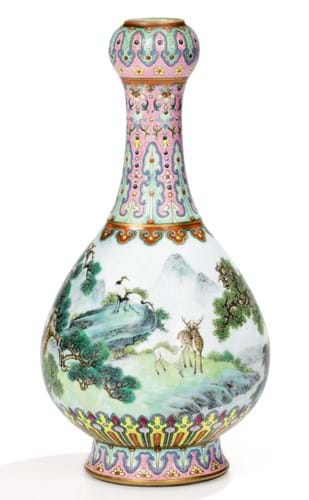
Against a modest €500,000-700,000 estimate, the lot drew a 20-minute bidding battle on June 12 with multiple phone lines booked for the sale. Sotheby’s said no information was available about the buyer’s identity.
While Qianlong vases appear relatively regularly at auction, the combination of form and, particularly, decoration made this example especially rare – the only known example of its kind according to the auctioneers.
The vendors were unaware of the item’s potential value and it was brought into the auctioneers’ Paris saleroom in a shoe box.
It was identified by Sotheby’s specialist Olivier Valmier as an apparently unique imperial 18th century ‘yangcai’ famille-rose porcelain vase.
The price was the highest ever for any lot sold at Sotheby’s Paris and also a new high for a piece of Chinese porcelain sold at auction in France. However, it was not a record for a piece of Chinese art in France – that distinction belongs to Toulouse auction house Labarbe which sold a 24m scroll depicting the army of the Qianlong emperor for 17.8m (£16.2m) in March 2011.
The record for an individual lot sold in France remains the €38.5m (£33.5m) for a stone head sculpture by Amedeo Modigliani sold at Christie’s Paris in June 2010.
The vase at Sotheby’s, produced by the Jingdezhen workshops for the Qianlong court, was left to the vendor’s grandparents by an uncle. According to a list of contents kept in his Paris apartment at the time of his death in 1947, he also owned other Chinese and Japanese objects including an unusual bronze mirror contained in a carved lacquer box which will also be offered at Sotheby’s.
‘Yangcai’ means ‘foreign colours’ in Chinese and refers to the over-glaze painting with transparent enamels. Objects were usually decorated with Western-style compositions and are often either unique or made in pairs.
The body of the vase at Sotheby’s is decorated with a landscape with deer, cranes and pine trees, all auspicious symbols of health and longevity. The landscape likely derives from one of the Imperial parks with the fallow deer representing happiness and prosperity and the cranes personifying old age.
Only one similar vase in terms of the combination of shape and design is known, although the example in the Guimet Museum in Paris has a slightly different subject matter and border decoration.
The Imperial inventories drawn up in the 18th century twice mention a pair of vases with this design: one pair commissioned in 1765; the other ordered as a birthday gift in 1769.






